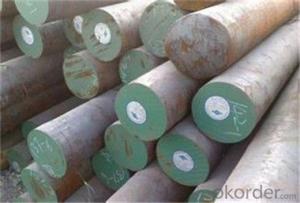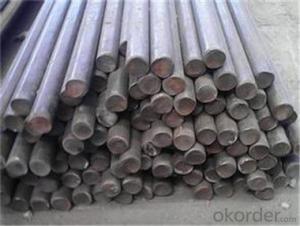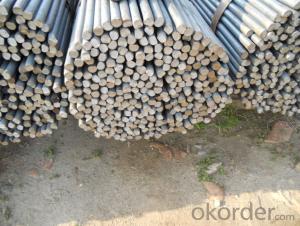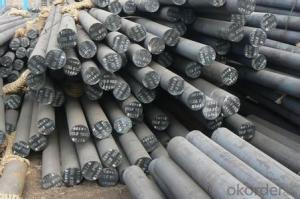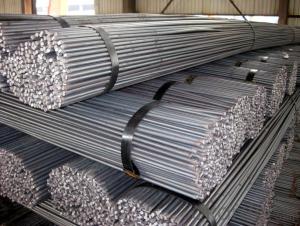42CrMO Forged or Hot Rolled Sae 4140 Steel Round Bars
- Loading Port:
- Tianjin
- Payment Terms:
- TT OR LC
- Min Order Qty:
- 332 m.t.
- Supply Capability:
- 2000000 m.t./month
OKorder Service Pledge
OKorder Financial Service
You Might Also Like
Description of steel round bar:
Mild Steel Round Bar is used for making security grills, screens, Construction and Machine Manufacture.Stainless steel bar is widely used in Architecture,Machine Manufacture,Power Station,Electric Equipment and Factory,Oil and Chemical Industry,Food and Medical Industry,City Decoration Industry
Festures of steel round bar:
Length: standard 6m,9m,12m, or as customers' requirement
Surface: Black, polished, grinded, ,Bright, Turn smooth(Peeled),Brush,Mill,Pickled
Process:Hot rolled,cold drawn,forged
Packing: In bundle, tied by steel straps, covered with protecting film
Use wooden box, fill with foam to keep the surface from damaging
Specifications of steel round bar:
Description : Steel Bar/Stainless Steel Round Bar/Alloy Steel Round Bar/Carbon Steel Bar
Stainless Steel Bright Bar/Stainless Steel Peeled Bar/Stainless Steel Polishing Bar
Diamater:
1 Hot rolled round bar diameter from 5.5mm to 110mm
2.Hot forged round bar diameter from 110mm to 400mm
3.Cold drawn round bar diameter from 2.0mm to 60mm
4.Grinding bar diameter from 4.0mm to 40mm
5.Turn smooth diameter from 40mm to 250mm
Images of steel round bar:
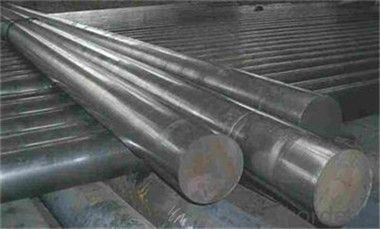
FAQ:
1. What is your main market?
We mainly export to Asia such as Japan,Korea,Thailand and North America and Middle East.
2. How long is the lead time?
Delivery time: 45 days after order confirmed.
3. What payment term do you accept?
Payment: T/T or L/C at sight.
4.Why do you choose to cooperate with us?
We have over10 years experience in this business so we are able to provide you the high quality products with the best price.
- Q:What are the different types of steel round bar shapes?
- There is a wide range of steel round bar shapes to choose from, each possessing its own distinctive characteristics and uses. Some commonly seen types include: 1. Round: This shape is the most commonly used and versatile for steel round bars. It takes on a cylindrical form and finds application in various industries like construction, manufacturing, and automotive. 2. Square: Square steel round bars feature four equal sides and are often employed when a robust and sturdy form is needed. They are frequently utilized in construction, architectural designs, and machinery. 3. Hexagonal: Hexagonal steel round bars boast six sides, setting them apart with their unique shape. They are often selected for applications requiring high strength and corrosion resistance, such as aerospace, defense, and oil and gas industries. 4. Flat: Flat steel round bars exhibit a rectangular cross-section with flat top and bottom surfaces. They are commonly used when a broad, level surface is desired, as in construction, machinery, and manufacturing sectors. 5. Half Round: Half-round steel round bars adopt a semicircular shape with a flat base. They are frequently employed for handrails, fencing, and decorative purposes. 6. D-shaped: D-shaped steel round bars possess a flat bottom surface and a curved top surface, resembling the letter "D". They are often favored when a sturdy yet lightweight structure is required, such as in automotive frames and chassis. These examples merely scratch the surface of the various steel round bar shapes available. The choice of shape hinges upon the specific requirements of the application, encompassing factors like strength, durability, corrosion resistance, and aesthetic appeal.
- Q:Can steel round bars be used in the manufacturing of firearms?
- Yes, steel round bars can be used in the manufacturing of firearms. Steel is a commonly used material in the construction of firearms due to its high strength and durability. Steel round bars can be machined and shaped into various components of a firearm, such as barrels, bolts, receivers, and triggers. The hardness and quality of the steel used in firearms manufacturing is crucial to ensure the reliability and safety of the firearm. Therefore, steel round bars that meet the necessary specifications and standards are commonly used in the production of firearms.
- Q:What is hot rolling? What is called forging?
- And there is no essential difference between the rolling and forging are relying on the plastic deformation of the blank but only the blank rolling machine plates or other similar things can be put in the sheet metal forging blank is processed into a more complex shape
- Q:What are the options for joining steel round bars?
- There are several options for joining steel round bars, depending on the specific requirements and applications. Some common methods include welding, bolting, and adhesives. 1. Welding: Welding is a widely used method for joining steel round bars. It involves melting the ends of the bars and fusing them together using a welding process such as arc welding, MIG welding, or TIG welding. Welding provides a strong and durable joint that can withstand high loads and stresses. 2. Bolting: Bolting involves using bolts, nuts, and washers to join steel round bars. Holes are drilled through the bars, and bolts are inserted through these holes. The nuts are then tightened to secure the bars together. Bolting is a relatively simple and quick method, and it allows for disassembly and reassembly if required. 3. Adhesives: Adhesives can also be used to join steel round bars. High-strength industrial adhesives are applied to the mating surfaces of the bars, which are then pressed together and left to cure. Adhesive bonding can provide a strong and durable joint, particularly in applications where welding or bolting may not be feasible or desired. 4. Mechanical couplings: Mechanical couplings are specifically designed for joining steel round bars. These couplings typically consist of two separate components that are fitted over the ends of the bars and tightened together using screws, clamps, or other mechanical means. Mechanical couplings provide a reliable and secure joint without the need for welding or drilling. 5. Cold forming: In some cases, steel round bars can be joined through cold forming techniques such as swaging or crimping. These methods involve mechanically deforming the ends of the bars to create a tight and secure joint. Cold forming is often used in applications where welding or other traditional methods are not suitable. It is important to consider the specific requirements, load-bearing capacities, and environmental conditions when selecting the appropriate method for joining steel round bars. Consulting with a professional engineer or welder can help determine the best option based on the specific application and desired outcome.
- Q:Are lightning checks required for galvanized steel, flat steel and round steel?
- When you buy hot galvanized round steel and flat steel, please provide inspection documents. In addition, in the procurement of materials must be explained that hot galvanizing, or else the business to provide you with cold plating will not work; there is a certain price gap between the two.
- Q:What are the advantages of using nickel-silicon alloy steel round bars?
- Using nickel-silicon alloy steel round bars offers several advantages. Firstly, this alloy provides excellent resistance to corrosion and oxidation, making it highly durable and suitable for various applications in harsh environments. Secondly, the presence of nickel enhances the material's strength and toughness, making it ideal for use in high-stress applications. Additionally, the silicon content improves the alloy's heat resistance, allowing it to withstand elevated temperatures without significant deformation. Overall, nickel-silicon alloy steel round bars offer a combination of corrosion resistance, strength, toughness, and heat resistance, making them a preferred choice in numerous industries such as aerospace, automotive, and chemical.
- Q:Can steel round bars be heat treated to improve their mechanical properties?
- Yes, steel round bars can be heat treated to improve their mechanical properties. Heat treatment is a process that involves heating the steel to a specific temperature, holding it at that temperature for a certain period of time, and then cooling it rapidly or slowly. This process can alter the microstructure of the steel, resulting in changes to its hardness, strength, toughness, and other mechanical properties. There are several types of heat treatment processes that can be used on steel round bars, depending on the desired outcome. For example, annealing is a heat treatment process that involves heating the steel to a specific temperature and then slowly cooling it. This process helps to relieve internal stresses in the steel, improve its ductility, and make it easier to machine. Another common heat treatment process is quenching and tempering. This involves heating the steel to a specific temperature and then rapidly cooling it, usually by immersing it in a quenching medium such as oil or water. This rapid cooling process helps to harden the steel, making it stronger and more resistant to wear and abrasion. After quenching, the steel is often tempered by reheating it to a lower temperature, which helps to reduce its brittleness and improve its toughness. In addition to annealing and quenching and tempering, other heat treatment processes such as normalizing, case hardening, and precipitation hardening can also be used to improve the mechanical properties of steel round bars. These processes involve different heating and cooling techniques, and are used to achieve specific outcomes based on the desired properties of the steel. Overall, heat treatment is a versatile and effective method for improving the mechanical properties of steel round bars. By carefully controlling the heating and cooling process, it is possible to achieve significant improvements in hardness, strength, toughness, and other properties, making the steel suitable for a wide range of applications.
- Q:How do you calculate the deflection of a steel round bar?
- To calculate the deflection of a steel round bar, you can use the Euler-Bernoulli beam theory formula, which states that the deflection is proportional to the applied load, the length of the bar, and the fourth power of its diameter. By inputting these values into the formula, you can determine the deflection of the steel round bar.
- Q:Can steel round bars be used for hydraulic applications?
- Indeed, hydraulic applications do permit the use of steel round bars. Renowned for its robustness and endurance, steel proves a fitting substance for hydraulic systems demanding intense pressure and substantial burdens. Steel round bars facilitate the production of diverse hydraulic constituents, including cylinders, pistons, shafts, and valves. Moreover, steel's sturdiness and resistance to corrosion render it an unwavering option for hydraulic applications wherein the fluid may harbor impurities or undergo elevated temperatures. Nonetheless, it remains crucial to ponder over the specific prerequisites of the hydraulic application and meticulously choose the grade and type of steel round bars to ensure supreme performance and longevity.
- Q:What is the tolerance for diameter in steel round bars?
- The tolerance for diameter in steel round bars can vary depending on the specific standards and requirements set by the manufacturer or industry. Generally, the tolerance for diameter in steel round bars is specified within a certain range to ensure the desired level of precision and consistency in the dimensions of the bars. This tolerance is usually expressed as a plus or minus value, indicating the acceptable deviation from the specified diameter. It is important to check the relevant industry standards or consult with the manufacturer to determine the specific tolerance for diameter in steel round bars, as it can differ based on the intended application and the manufacturing process used.
1. Manufacturer Overview |
|
|---|---|
| Location | |
| Year Established | |
| Annual Output Value | |
| Main Markets | |
| Company Certifications | |
2. Manufacturer Certificates |
|
|---|---|
| a) Certification Name | |
| Range | |
| Reference | |
| Validity Period | |
3. Manufacturer Capability |
|
|---|---|
| a)Trade Capacity | |
| Nearest Port | |
| Export Percentage | |
| No.of Employees in Trade Department | |
| Language Spoken: | |
| b)Factory Information | |
| Factory Size: | |
| No. of Production Lines | |
| Contract Manufacturing | |
| Product Price Range | |
Send your message to us
42CrMO Forged or Hot Rolled Sae 4140 Steel Round Bars
- Loading Port:
- Tianjin
- Payment Terms:
- TT OR LC
- Min Order Qty:
- 332 m.t.
- Supply Capability:
- 2000000 m.t./month
OKorder Service Pledge
OKorder Financial Service
Similar products
New products
Hot products
Related keywords
